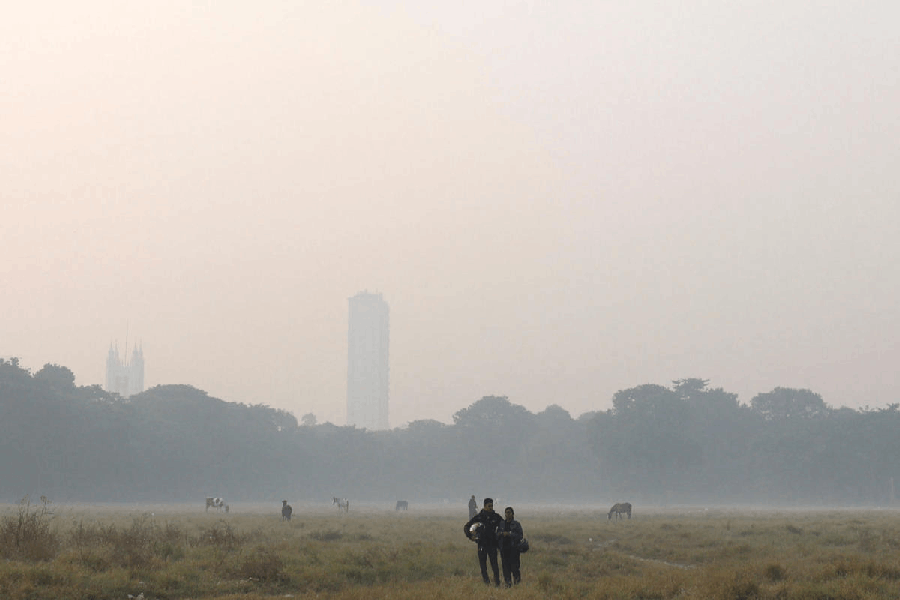About 25 families from various shelters in Joshimath returned to their damaged houses on Monday night after hearing unconfirmed reports that they would not receive enough compensation to be able to settle somewhere else, reflecting the insecurity and distrust of the government among the evacuees.
These 100-odd people spent the cold night around bonfires on the terraces of their homes, whose walls and floors have developed cracks and fissures because of land subsidence. They returned to the government shelters on Tuesday morning after local officials arrived and assured them they would be given adequate compensation.
The residents complained that the delay in declaring the compensation amount was fuelling apprehensions about the government’s intent.
“We have no official word on the compensation but heard from someone that while the damaged commercial buildings are being assessed at Rs 3,250 per square foot, owners of residential properties will get Rs 2,750 per square foot,” Digambar Singh Bist, a resident, told reporters.
“While we followed norms in the construction of our houses, the hotels were built by violating all rules. However, the government is sympathetic towards the businessmen and is victimising us. We need more than Rs 2,750 per sqft or we will not leave our houses.”
Anjali Rawat, another resident, said: “The government seems not to understand that the delay in surveying our damaged houses is making us restless. Anger is growing among the people. We are living in shelters in the most unhygienic and pathetic conditions with our children. We can’t live like this for many weeks.”
Himanshu Khurana, district magistrate of Chamoli where Joshimah is located, said: “Meetings are on to fix the rates for the damaged properties in Joshimath. The people’s expectations will not be ignored in deciding the compensation.”
However, Hem Lata, a resident, said: “My house developed cracks on January 3 and we were made to leave the place the same day. Nobody has visited my house till now to survey it. The delay is sowing doubts in our minds about the intention of the government.”
D.P. Kanungo, chief scientist at the Central Building Research Institute, Roorkee, suggested that assessing the damage and fixing compensation for each house will take time.
“We are working with teams from the public works department and other government departments to assess the damage to the buildings,” he said.
A member of a multi-disciplinary team formed by the state government a week ago to study the subsidence crisis said on the condition of anonymity that the situation would improve in summer, when the moisture in the soil would dry up. He said that members of the Wadia Institute of Himalayan Geology, National Institute of Hydrology, IIT Roorkee, Geological Survey of India and the Indian Institute of Remote Sensing had visited the affected area in Joshimath and the banks of the Alakhnanda and Dhauliganga rivers.
“They found that the developments of 2021 had hastened the process of land subsidence in Joshimath. A huge quantity of water flowed down the two rivers last year, causing rapid erosion of sand and soil along the riverbanks,” he said.
He added: “Further, Joshimath has a population of about 30,000. If each individual uses 100 litres of water a day, 30 lakh litres are discharged (into the soil) every day.
“Since there is no drainage system, the discharged water goes into the earth and builds up hydrostatic pressure. Developing a drainage system and making deep holes where the walls of government projects retain water (block the flow) will help the water flow down to the rivers without damaging the soil.”
Twenty-three more houses have developed cracks in the last 24 hours. Some 849 of Joshimath’s about 10,000 houses were listed as damaged on Tuesday. Of these, the government assesses that about 250 need to be abandoned.
The member of the multi-disciplinary team said that the hydropower projects of the National Thermal Power Corporation (NTPC) were one reason behind the land subsidence. The NTPC has said it takes extreme care not to harm the environment and that it has never conducted any activity right below Joshimath.












